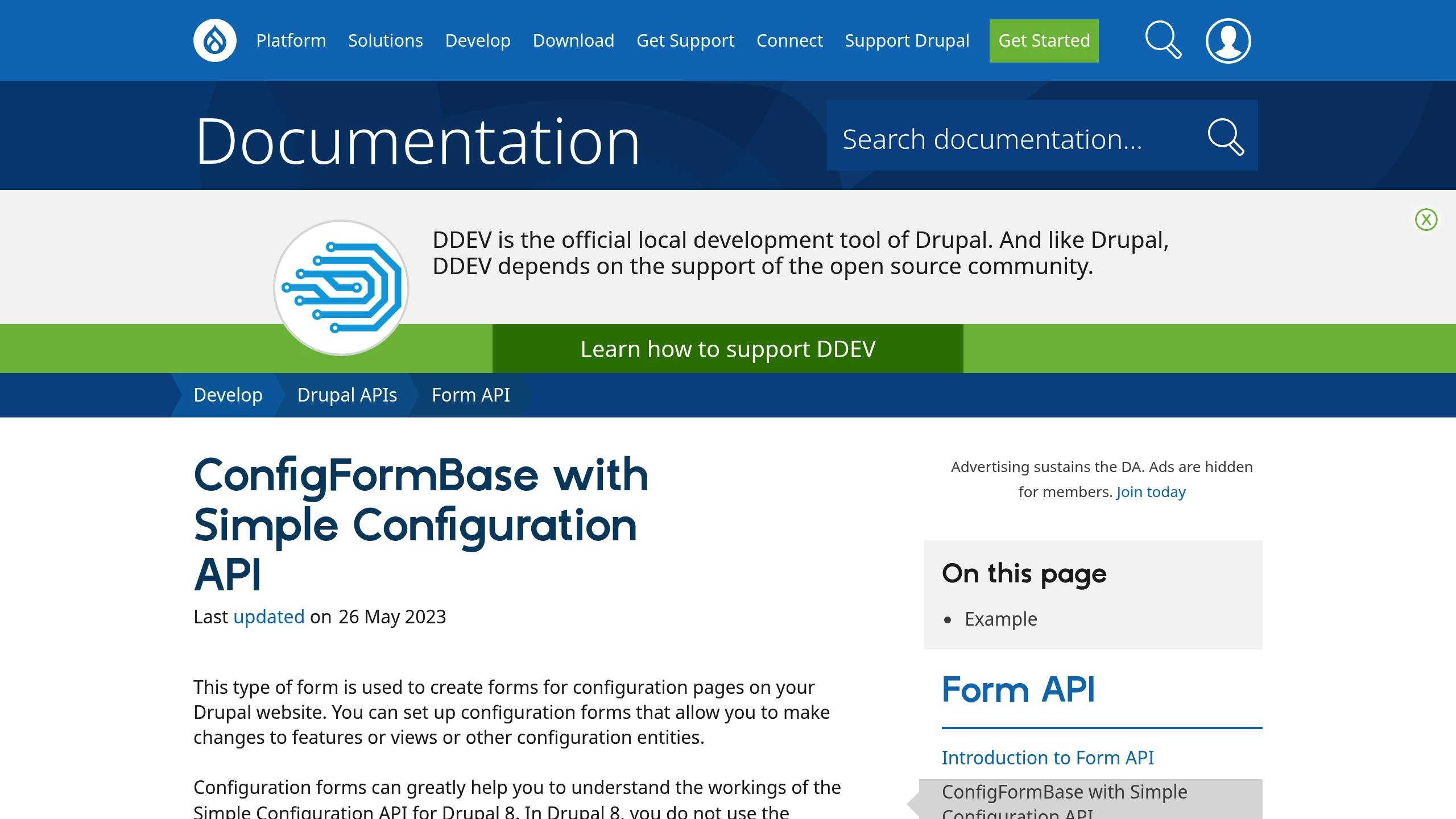Want to create a custom form in Drupal? Here’s a quick guide to get started:
- Set Up a Custom Module: Create a module with a proper directory structure and
.info.ymlfile. - Build a Form Class: Use
ConfigFormBaseto design your form and manage configurations. - Add Form Fields: Define fields like text inputs, checkboxes, and emails, pulling default values from your configuration.
- Set Up Routing and Menus: Create
.routing.ymland.links.menu.ymlfiles to make your form accessible in the admin interface. - Save and Retrieve Data: Use Drupal’s configuration system to handle form data securely and efficiently.
With these steps, you can build forms for site settings, data collection, or any custom functionality. Keep reading for detailed instructions and examples.
Create a Custom Module
To build your form, start by creating a custom module. Drupal requires a specific directory structure and naming conventions for modules, so let’s break it down.
Module File Structure
Your custom module should include these essential files:
custom_module/
├── custom_module.info.yml
├── custom_module.routing.yml
├── custom_module.links.menu.yml
└── src/
└── Form/
└── CustomConfigForm.php
Make sure the module name is lowercase and uses underscores. Place it in the modules/custom directory of your Drupal installation. This keeps your custom code separate from Drupal core and contributed modules.
Setting Up the .info.yml File
The .info.yml file defines your module’s basic information. Here’s an example:
name: Custom Module
type: module
description: 'Provides a custom configuration form.'
package: Custom
core_version_requirement: ^9 || ^10
configure: custom_module.settings
Key elements in this file:
- name: The module’s name as it appears in the admin interface.
- type: Always "module" for custom modules.
- core_version_requirement: Specifies the Drupal core versions your module supports.
- description: A short explanation of what your module does.
- package: Groups your module under a specific category in the admin interface.
- configure: Points to your form’s route, adding a "Configure" link in the Extend page.
Enabling the Module
Once your files are set up, enable the module through the admin interface at /admin/modules or use Drush:
drush en custom_module
After enabling, clear Drupal’s cache to ensure all the new files are properly loaded:
drush cr
With the module enabled, you’re ready to create the form class for your custom configuration form.
Create the Form Class
With your module structure ready, it’s time to create the form class that will manage your configuration settings. This class will extend ConfigFormBase, making use of Drupal’s built-in configuration system.
Use ConfigFormBase Class

Start by creating a new file called CustomConfigForm.php in your module’s src/Form directory. Use the following structure as a starting point:
namespace Drupal\custom_module\Form;
use Drupal\Core\Form\ConfigFormBase;
use Drupal\Core\Form\FormStateInterface;
class CustomConfigForm extends ConfigFormBase {
// Form implementation will go here
}
The ConfigFormBase class simplifies how configuration is stored and processed in forms.
Add Required Methods
Next, implement these methods to connect your form to Drupal’s configuration system:
protected function getEditableConfigNames() {
return ['custom_module.settings'];
}
public function getFormId() {
return 'custom_module_settings';
}
Add Form Fields
Now, expand the form by defining fields for your configuration settings:
public function buildForm(array $form, FormStateInterface $form_state) {
$config = $this->config('custom_module.settings');
$form['settings'] = [
'#type' => 'vertical_tabs',
'#title' => $this->t('Settings'),
];
$form['general'] = [
'#type' => 'details',
'#title' => $this->t('General Settings'),
'#group' => 'settings',
];
$form['general']['site_name'] = [
'#type' => 'textfield',
'#title' => $this->t('Site Name'),
'#default_value' => $config->get('site_name'),
'#required' => TRUE,
'#maxlength' => 64,
];
$form['general']['email'] = [
'#type' => 'email',
'#title' => $this->t('Email'),
'#default_value' => $config->get('email'),
'#required' => TRUE,
];
$form['general']['enable_feature'] = [
'#type' => 'checkbox',
'#title' => $this->t('Enable Feature'),
'#default_value' => $config->get('enable_feature'),
'#description' => $this->t('Toggle this feature on/off'),
];
return parent::buildForm($form, $form_state);
}
public function submitForm(array &$form, FormStateInterface $form_state) {
$this->config('custom_module.settings')
->set('site_name', $form_state->getValue('site_name'))
->set('email', $form_state->getValue('email'))
->set('enable_feature', $form_state->getValue('enable_feature'))
->save();
parent::submitForm($form, $form_state);
}
Here’s what you should keep in mind when defining form fields:
- Use descriptive machine names for field keys.
- Wrap user-facing strings in
$this->t()to enable translation. - Pull default values from the configuration to pre-fill fields.
- Add clear descriptions for fields that might need explanation.
- Group related fields using the
detailselement for better organization. - Validate input through form validation methods as necessary.
This example shows how to efficiently collect and store settings like the site name, email, and a feature toggle option.
sbb-itb-f1cefd0
Set Up Routes and Menus
Make your form available in Drupal’s admin interface by setting up routes and menus.
Create the .routing.yml File
Define the route for your form in a file named custom_module.routing.yml:
custom_module.settings_form:
path: '/admin/config/system/custom-module'
defaults:
_form: '\Drupal\custom_module\Form\CustomConfigForm'
_title: 'Custom Module Settings'
requirements:
_permission: 'administer site configuration'
options:
_admin_route: TRUE
Here’s what this configuration does:
- Defines the URL for your form and how it should be handled.
- Specifies the form class to be used.
- Sets access permissions for who can view the form.
- Marks it as an admin route for proper categorization in the admin interface.
Once the route is set, the next step is to link it to the admin menu.
Add Admin Menu Links
To make your form accessible through the admin menu, create a file called custom_module.links.menu.yml in your module’s root directory:
custom_module.admin_settings:
title: 'Custom Module'
description: 'Configure custom module settings'
parent: system.admin_config_system
route_name: custom_module.settings_form
weight: 100
This configuration will:
- Add your form under the System section in the admin menu.
- Display a descriptive title and tooltip for the menu link.
You can also add a local tasks menu for the module’s configuration:
custom_module.settings_task:
route_name: custom_module.settings_form
title: 'Settings'
base_route: custom_module.settings_form
Finally, clear the cache to apply your changes:
drush cr
Now, your form will be accessible via:
- The admin menu under Configuration → System → Custom Module.
- The local tasks menu when viewing the module’s configuration page.
Work with Form Data
In Drupal, you can access saved configurations in other module components using ConfigFactoryInterface. This method helps keep your module organized and easier to maintain by leveraging Drupal’s configuration management system.
Retrieve Saved Settings
Here’s how you can retrieve saved settings in your code:
use Drupal\Core\Config\ConfigFactoryInterface;
class YourClass {
protected $configFactory;
public function __construct(ConfigFactoryInterface $configFactory) {
$this->configFactory = $configFactory;
}
public function getSavedSettings() {
$config = $this->configFactory->get('custom_module.settings');
$value = $config->get('your_field_name');
return $value;
}
}
Practical Code Examples
Below are examples of how to work with form data in various scenarios:
// Example 1: Retrieve a single configuration value
$config = $this->configFactory->get('custom_module.settings');
$emailAddress = $config->get('notification_email');
// Example 2: Retrieve multiple values with default fallbacks
$settings = $config->get();
$emailAddress = $settings['notification_email'] ?? '[email protected]';
$threshold = $settings['alert_threshold'] ?? 100;
// Example 3: Use configuration in a service
public function sendNotification($message) {
$config = $this->configFactory->get('custom_module.settings');
$recipientEmail = $config->get('notification_email');
$notificationEnabled = $config->get('enable_notifications');
if ($notificationEnabled) {
// Logic for sending the notification
$this->mailer->send($recipientEmail, $message);
}
}
When retrieving configuration values, it’s a good idea to use the null coalescing operator (??) to provide default values. You should also validate data types and ensure your configuration schema is defined.
Handling Complex Configurations
For more complex configuration structures, consider using a dedicated service class. This keeps your code cleaner and adheres to dependency injection principles:
use Drupal\Core\Config\ConfigFactoryInterface;
class ConfigurationManager {
protected $configFactory;
public function __construct(ConfigFactoryInterface $configFactory) {
$this->configFactory = $configFactory;
}
public function getNotificationSettings(): array {
$config = $this->configFactory->get('custom_module.settings');
return [
'enabled' => (bool) $config->get('enable_notifications'),
'email' => $config->get('notification_email'),
'frequency' => $config->get('notification_frequency'),
];
}
}
Using a dedicated service class provides a reusable and structured way to access your module’s configuration. This approach not only keeps your codebase consistent but also aligns with service-oriented architecture best practices.
Conclusion
Now that you’ve gone through the steps, here’s a quick recap and some ideas to take your form to the next level.
Summary Steps
Here’s what you’ve done so far:
- Module Setup: Created a custom module with the correct file structure and a
.info.ymlfile. - Form Class: Extended
ConfigFormBaseand implemented the necessary methods. - Routes: Configured a
.routing.ymlfile to provide access to the form. - Menu: Set up a
.links.menu.ymlfile to make the form visible in the admin menu. - Configuration: Used
custom_module.settingsingetEditableConfigNamesfor managing settings.
Next Steps
Want to enhance your form? Here are some ideas:
- Form Validation: Use the
validateForm()method to add custom validation rules and ensure data integrity. - AJAX Integration: Introduce dynamic updates and real-time interactions to make your form more user-friendly.
- Advanced Features: Explore options like multi-step workflows, file uploads, custom field types, form state management, or conditional elements for more complex requirements.
These additions can make your form more dynamic and tailored to specific needs.





